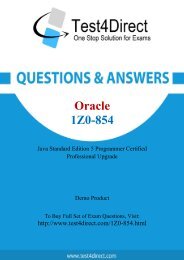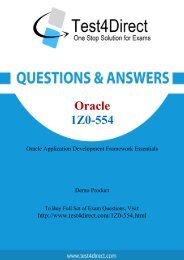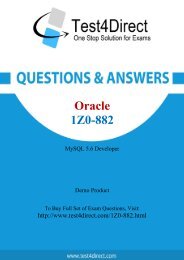Download 1Z0-409 BrainDumps to Success in career
Test4Direct provides latest PDF questions of Oracle 1Z0-409 exam. You have an opportunity to pass the Oracle 1Z0-409 exam in one go. Test4Direct is most accurate source to prepare Oracle 1Z0-409 exam as your success will become site’s responsibility after purchasing 1Z0-409 exam product. There are also lots of discounts and promotion offers that you can avail. Let’s try a free demo http://www.test4direct.com/1Z0-409.html
Test4Direct provides latest PDF questions of Oracle 1Z0-409 exam. You have an opportunity to pass the Oracle 1Z0-409 exam in one go. Test4Direct is most accurate source to prepare Oracle 1Z0-409 exam as your success will become site’s responsibility after purchasing 1Z0-409 exam product. There are also lots of discounts and promotion offers that you can avail. Let’s try a free demo http://www.test4direct.com/1Z0-409.html
You also want an ePaper? Increase the reach of your titles
YUMPU automatically turns print PDFs into web optimized ePapers that Google loves.
Oracle<br />
<strong>1Z0</strong>-<strong>409</strong><br />
Oracle L<strong>in</strong>ux Fundamentals<br />
Demo Product<br />
To Buy Full Set of Exam Questions, Visit:<br />
http://www.test4direct.com/<strong>1Z0</strong>-<strong>409</strong>.html
Question: 1<br />
You located a file created <strong>in</strong> /home successfully by us<strong>in</strong>g the slocate command. You found that the<br />
slocate command could locate that file even after deletion. What could be the possible solution <strong>to</strong><br />
s<strong>to</strong>p list<strong>in</strong>g deleted files? (Choose all that apply.)<br />
A. Run updatedb <strong>to</strong> update the database.<br />
B. Run slocate -u <strong>to</strong> update the database.<br />
C. Use the locate command <strong>in</strong>stead of slocate.<br />
D. Delete the /var/lib/slocate/slocate.db file because it buffers all search results.<br />
E. Reboot the system so that it will update the kernel memory because the kernel s<strong>to</strong>res all results <strong>in</strong><br />
the memory.<br />
Question: 2<br />
Question: 3<br />
Question: 4<br />
Answer: A,B<br />
As an adm<strong>in</strong>istra<strong>to</strong>r, you mounted the /exports/projects NFS exported direc<strong>to</strong>ry from a server on a<br />
LAN us<strong>in</strong>g the default NFS sett<strong>in</strong>gs. You f<strong>in</strong>d the performance <strong>to</strong> be low. Which NFS mount options<br />
can you use <strong>to</strong> <strong>in</strong>crease the performance?<br />
A. set rsize=8192 and wsize=8192.<br />
B. set rsize=32768 and wsize=32768.<br />
C. set wsize=8192 and keep the read packet size at the default.<br />
D. set rsize=8192 and keep the write packet size at the default.<br />
E. set rsize=32768 and keep the write packet size at the default.<br />
F. set wsize=32768 and keep the read packet size at the default.<br />
Answer: A<br />
Two users, bob on station1 and smith on station2, generated a public/private key pair us<strong>in</strong>g<br />
sshkeygen <strong>to</strong> enable password-less secure shell log<strong>in</strong> between them. What would be their next step<br />
<strong>to</strong> accomplish the task?<br />
A. Copy the private key of bob <strong>to</strong> station2:~smith and vice versa.<br />
B. Copy the key pair of bob <strong>to</strong> station2:~smith/.ssh as public and private keys.<br />
C. Copy the private key of bob <strong>to</strong> station2:~smith/.ssh/authorized_keys and vice versa.<br />
D. Copy the public key of bob <strong>to</strong> station1:~smith/.ssh/authorized_keys and vice versa.<br />
E. Copy the public key of bob <strong>to</strong> station2:~smith/.ssh/authorized_keys and vice versa.<br />
Answer: E
View the Exhibit.<br />
As a L<strong>in</strong>ux adm<strong>in</strong>istra<strong>to</strong>r, you have <strong>to</strong> let the users smith and scott manage files and direc<strong>to</strong>ries <strong>in</strong> the<br />
/software direc<strong>to</strong>ry on their own, with full permissions between each other's files. What are the<br />
most essential steps needed <strong>to</strong> grant them the required privileges? (Choose all that apply.)<br />
A. Add SUID on /software.<br />
B. Add 777 permissions on /software.<br />
C. Add u=--- permissions on /software.<br />
D. Add scott as a member of the apps group.<br />
E. Add rwx permissions for the apps group on /software.<br />
Question: 5<br />
View the Exhibit.<br />
Answer: D,E<br />
A normal user bob logs <strong>in</strong> from server200 <strong>to</strong> server1 through telnet and runs the xclock command<br />
but fails with an error message as shown <strong>in</strong> the Exhibit. What could be the possible reason for the<br />
error?<br />
A. This is because gdm is not started on the mach<strong>in</strong>e.<br />
B. This is because of the temporary failure <strong>in</strong> name resolution.<br />
C. This is because the default X access controls do not permit remote connections.<br />
D. This is because the graphical display manager is not configured <strong>to</strong> allow TCP connections.<br />
Question: 6<br />
Answer: D
What is the effect of issu<strong>in</strong>g ZZ and ZQ <strong>in</strong> the vi edi<strong>to</strong>r command mode?<br />
A. The command ZZ will zoom <strong>in</strong> the vi edi<strong>to</strong>r command mode and ZQ will zoom out the view.<br />
B. The command ZZ will thrash all changes, whereas ZQ will ask for confirmation before sav<strong>in</strong>g.<br />
C. The command ZZ will save changes and exit, whereas ZQ will exit the edi<strong>to</strong>r without sav<strong>in</strong>g<br />
changes.<br />
D. The command ZZ will exit the edi<strong>to</strong>r without sav<strong>in</strong>g changes, whereas ZQ will save changes and<br />
exit.<br />
Question: 7<br />
Question: 8<br />
Question: 9<br />
Answer: C<br />
You have logged <strong>in</strong> as root and have <strong>in</strong>voked the mount command without any options <strong>to</strong> mount the<br />
device /dev/hda8<br />
mount /dev/hda8<br />
What does mount do <strong>in</strong> this context? (Choose two.)<br />
A. It checks the /etc/mtab for the required options <strong>to</strong> mount the device.<br />
B. It checks the /etc/fstab for the required options and the mount po<strong>in</strong>t <strong>to</strong> mount the device.<br />
C. It checks the /etc/<strong>in</strong>ittab for the required options and the mount po<strong>in</strong>t <strong>to</strong> mount the device.<br />
D. It reports an error message "mount po<strong>in</strong>t doesn't exist" if the entry for /dev/hda8 doesn't exist <strong>in</strong><br />
the /etc/fstab file.<br />
Answer: B,D<br />
Which command would you use <strong>to</strong> save the name of all the users <strong>in</strong> your system <strong>in</strong> alphabetical<br />
order <strong>to</strong> a newfile file after remov<strong>in</strong>g the duplicate entries?<br />
A. cut -f1 -d: /etc/passwd | sort | uniq | > newfile<br />
B. cut -f1 -d: /etc/passwd | sort -d | uniq > newfile<br />
C. cut -f1 -d: /etc/passwd | sort -a | uniq | newfile<br />
D. cut -f1 -d: < /etc/passwd | sort | uniq | less < newfile<br />
Which four statements are true about the f<strong>in</strong>d command <strong>in</strong> L<strong>in</strong>ux? (Choose four.)<br />
A. The user can specify how <strong>to</strong> process the files.<br />
B. The user can specify where <strong>to</strong> search (pathname).<br />
C. The user can specify what type of file <strong>to</strong> search for.<br />
D. The user can specify <strong>to</strong> perform logical operations on selections.<br />
E. The user can search and replace the contents of files with f<strong>in</strong>d.<br />
F. The user cannot f<strong>in</strong>d recently added files or direc<strong>to</strong>ries on the system.<br />
Answer: B
Answer: A,B,C,D<br />
Question: 10<br />
The user smith wants <strong>to</strong> display the <strong>to</strong>tal number of l<strong>in</strong>es that are 4 characters (letters and digits)<br />
long or more from the file1.txt file. Which regular expression or command should smith use?<br />
A. egrep "^[[:alnum:]]{4,}$" file1.txt | wc -l<br />
B. egrep "^[[:alpha:]]{4,}$" file1.txt | wc -l<br />
C. egrep "^[[:alpha:]]{4,}$" file1.txt | wc -w<br />
D. egrep "^[[:alnum:]]{4,}$" file1.txt | wc -c<br />
Question: 11<br />
Question: 12<br />
Question: 13<br />
Answer: A<br />
Match the follow<strong>in</strong>g shell special characters with their usage:<br />
1) \ a) used <strong>in</strong> pairs <strong>to</strong> quote other special characters so they will not be <strong>in</strong>terpreted by the shell or <strong>to</strong><br />
embed blanks<br />
2) ' ? b) variable substitution<br />
3) { } ~ c) used <strong>to</strong> escape the special mean<strong>in</strong>g of the next character<br />
4) $ d) wildcard file name expansion<br />
A. 1-c, 2-b, 3-a, 4-d<br />
B. 1-b, 2-d, 3-c, 4-a<br />
C. 1-c, 2-a, 3-d, 4-b<br />
D. 1-c, 2-a, 3-b, 4-d<br />
E. 1-d, 2-a, 3-c, 4-b<br />
F. 1-d, 2-c, 3, b, 4-a<br />
Answer: C<br />
Match the commands with their functions:<br />
1. make a. <strong>in</strong>stalls the software <strong>to</strong> the target direc<strong>to</strong>ry specified dur<strong>in</strong>g configure, but typically<br />
defaults <strong>to</strong> /usr/local/subtree<br />
2. configure script b. calls the compiler and l<strong>in</strong>ker as specified by the Makefile<br />
3. make <strong>in</strong>stall c. creates the necessary Makefiles based on the user <strong>in</strong>formation<br />
A. 1-c, 2-a, 3-b<br />
B. 1-b, 2-c, 3-a<br />
C. 1-a, 2-c, 3-b<br />
D. 1-c, 2-b, 3-a<br />
Answer: B<br />
You have the /<strong>to</strong>ols direc<strong>to</strong>ry on a system with critical system files reserved for future use. As a L<strong>in</strong>ux
adm<strong>in</strong>istra<strong>to</strong>r which command would you use <strong>to</strong> protect these files from a user who might get the<br />
UID or GID as shown below?<br />
[root@server1 ~]# ls -ld /<strong>to</strong>ols/<br />
drwxrwx--- 108 517 527 <strong>409</strong>6 Mar 26 20:00 /<strong>to</strong>ols/<br />
A. chmod o+t /<strong>to</strong>ols<br />
B. chmod u+s /<strong>to</strong>ols<br />
C. chown -R 0.0 /<strong>to</strong>ols<br />
D. chown -R nobody.nobody /<strong>to</strong>ols<br />
Question: 14<br />
Question: 15<br />
Answer: C<br />
Identify the two ma<strong>in</strong> branches from the UNIX family tree, where the cross-poll<strong>in</strong>ation between<br />
these branches was responsible for mak<strong>in</strong>g UNIX so powerful. (Choose two.)<br />
A. MIT<br />
B. GNU<br />
C. BSD<br />
D. POSIX<br />
E. BESYS<br />
F. System V<br />
Answer: C,F<br />
You want <strong>to</strong> access data relevant <strong>to</strong> some runn<strong>in</strong>g processes <strong>in</strong> the system. Which direc<strong>to</strong>ry conta<strong>in</strong>s<br />
the system <strong>in</strong>formation describ<strong>in</strong>g the system and processes (for example, PID files) s<strong>in</strong>ce the system<br />
was booted?<br />
A. /sys<br />
B. /srv<br />
C. /proc<br />
D. /var/run<br />
E. /var/lock<br />
Answer: D
THANKS FOR TRYING THE DEMO OF OUR PRODUCT<br />
Visit Our Site <strong>to</strong> Purchase the Full Set of Actual <strong>1Z0</strong>-<strong>409</strong> Exam Questions With Answers.<br />
http://www.test4direct.com/<strong>1Z0</strong>-<strong>409</strong>.html<br />
We Also Provide Practice Exam Software That Simulates Real Exam Environment And Has<br />
Many Self-Assessment Features. <strong>Download</strong> Free Product Demo From:<br />
http://www.test4direct.com/<strong>1Z0</strong>-<strong>409</strong>.html<br />
Money Back Guarantee<br />
Check Out Our Cus<strong>to</strong>mer Testimonials


















